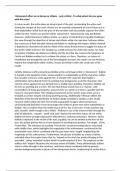‘Atonement offers us no heroes or villains – only victims’. To what extent do you agree
with this view?
In crime novels, the victim plays an integral part of the plot, accelerating the action and
driving the intrigue of the novel. Victims are an essential component of crime fiction as it is
their exploitation which fuels the pace of the narrative and successfully captures the villain
within the text. Victims are present within ‘Atonement’, epitomised by Lola and Robbie.
However, whilst Atonement utilises victims, as a piece of metafiction it arguably challenges
this view through the depiction of heroes and villains within the narrative. McEwan utilises
the constructs of Paul Marshall, Briony and Robbie to challenge this notion. Whilst Marshall
is depicted as inherently evil and the villain of the novel, Briony seems to juggle the status of
the victim, villain and hero: her isolation as a child portrays her victim-like status, her false
accusation of Robbie elucidates her villainy and the fact that she restores the happiness of
Cecilia and Robbie enables her to achieve the status as a hero. Therefore, as a piece of
metafiction and through the use of the homodiegetic narrator, the reader can see McEwan
explore the complexities within victims, heroes and villains within the constructs of his
novels.
Initially, McEwan crafts and portrays Robbie as the archetypal victim in ‘Atonement’. Robbie
is framed as the apodictic victim, whose position is undisputable as all the characters within
the narrative commit a crime against him. A Marxist critic could see that Robbie’s
victimisation stems directly from his working-class background, as all the characters who
commit crimes against him are derived from a middle-class standing. Therefore, Robbie can
be seen as anything but a victim. The fact that Briony brands him as a ‘maniac’, with
connotations of being psychopathic, presents him as a victim as it forms a parallel with his
innocent characterisation. This initially presents him as the novel’s main victim as he is
branded as sinister despite not doing anything wrong. Additionally, McEwan utilises the
depiction of the Second World War to further allude to Robbie’s position as the wholly
innocent victim within the text. The horrific and graphic imagery which presents an
unromanticised depiction of war encourages the reader to grow even more sympathetic to
Robbie. This is evident when the reader learns of the ‘leg’ in the tree; ‘It was a perfect leg,
pale, smooth, small enough to be a child’s’. McEwan’s use of the innocent lexis through the
triad of adjectives, ‘smooth’, ‘small’ and ‘pale’ depicts the merciless nature of war which
Robbie has been wrongly subjected to after Briony’s malicious behaviour. However, whilst
Robbie is depicted as the victim of the text, arguably, he can be viewed as the hero of the
text. His actions portray him as a hero despite his working-class position, ‘he taught… thirty
French kids’. The reference to teaching ‘French Kids’ would stereotypically be associated
with middle-class, which highlights the magnitude of his achievement, reinforced by the
quantitative noun ‘thirty’ combined with the past tense verb ‘taught’ emphasising the
magnitude of this achievement. Furthermore, the picture of Robbie as a hero is further
extended when the reader learns that he, ‘helped on the stretcher parties bringing in the
wounded’, aiding ‘wounded’ victims which is hardly required of him. The emphasis on the
selfless verb ‘helped’ illustrates the virtuous nature of Robbie. These philanthropic actions
seem to shine through in the construct, and these actions combined with his poverty-
stricken background paints a picture of him being more heroic, heightening his victim status.




